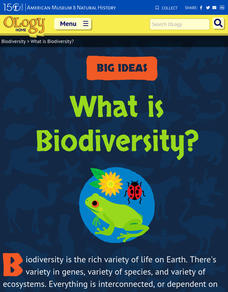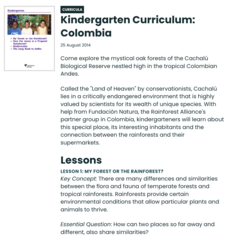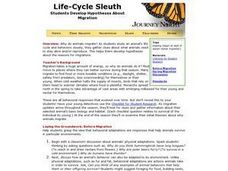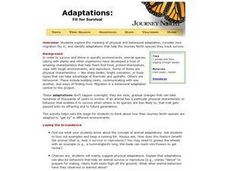Curated OER
Earth's Heavenly Treasures: Hummingbirds
Young ornithologists watch an informative video and use the Internet to gather data about the life, size, habitat, and migration of hummingbirds. The interdisciplinary lesson includes activities that target art, science, math, and...
Curated OER
Honing in on Hummingbirds
Students explore ruby-throated hummingbirds. For this cross-curricular hummingbirds lesson, students listen to the book The Mystery of the Missing Hummingbirds and choose related topics to research with a partner. Students draw or write...
Curated OER
Hummingbirds and Flowers: A Study of Co-Adaptive Relationships
Hummingbirds and flowers need each other to survive! Pupils explore the co-adaptation of hummingbirds and the flowering plants. They explain how a flowering plant has adapted to be pollinated by a hummingbird and how the hummingbird has...
Curated OER
Learning About Birds
Students look in their science book and the Internet to find information about the different types of birds such as wrens, robins, woodpeckers, sparrows, hummingbirds, and others and take notes. They then write a paper on the types of...
Curated OER
Science-Observation Skill Builders
Pupils explore observation while making connections between observation skills and careers (like how farmers observe the weather). They view a variety of nature photographs on the computer and practice their observation skills by...
American Museum of Natural History
What is Biodiversity?
Not all dogs are the same just like not all finches are the same. An interactive online lesson helps individuals learn about the causes and limitations to biodiversity. The clickable sections describe the basics of the genetics of...
Curated OER
My Forest or the Rainforest?
Students explore the flora and fauna of temperate forests and rainforests. They examine the environmental conditions that allow certain plants and animals to live in the rainforest.
Curated OER
Life-Cycle Sleuth
Students analyze an animal's life cycle and behaviors, and examine what animals need to stay alive and reproduce. They develop theories and hypotheses about the reasons for migrations, using the Journey North online project.
Curated OER
Pollinator Habitats
Students read and discuss background information included with this lesson. They brainstorm the best sources for developing a list of native or migratory pollinators. Students work in groups to design habitats based on information...
Curated OER
Literacy: Slowly, Slowly, Slowly Said the Sloth
Students explore language arts by analyzing a children's book in class. In this vocabulary lesson, students read the book Slowly, Slowly, Slowly... by Eric Carle. Students identify the characters, setting and plot of the story before...
Curated OER
Adaptations: Fit For Survival
Students track species using the Journey North project. They examine the meaning of physical and behavioral adaptation, migration, and identify adaptations that help the species they track survive.
Curated OER
Building a Dichotomous Key
Students analyze how a dichotomous key helps us explain and identify unknown organisms. They design and construct a dichotomous key, developing a list of three observable characteristics per organism.
Curated OER
Look Up - Birds
Students investigate the concept of birds. They identify five different types of birds and name the characteristics that make them different than other living things. Students also name the different parts of the bird and how they are...
Curated OER
Evolution of Life
Students explore the evolution of life. They read sections of their text and make a foldable of the key vocabulary terms. They identify two types of butterflies and represent their similarities and differences on a Venn diagram. They...
Curated OER
Activity: Bird Beak Buffet
Middle schoolers study the functions of bird beaks. In this animal evolution instructional activity, students compare and contrast different types of bird beaks focusing on how the beaks are adapted to the foods the birds eat. Middle...
Curated OER
Smarty Plants
Students examine plants and pollinators. In this plant biology lesson, students read The Power of Pollinators and identify the parts of the plant and the pollinators. Students design their own imaginary plants.
Curated OER
Choose Your Defense: Spines, Vomit and Camouflage
Students investigate defensive mechanisms of insects and organisms. In this biology lesson, students draw imaginary caterpillars as well as imaginary parasites that will harm the caterpillar. Students utilize the Internet to discover...
Curated OER
Bird Buffet
Fifth graders study traits of different bird beaks. In this bird lesson, 5th graders explore the function and usefulness of different inherited traits of birds.
Curated OER
Specialized Structures and Environments
Fifth graders explore biology by completing an Internet activity in class. In this adaptation lesson, 5th graders identify several organisms and mammals that fight for their existence through slow changes to their anatomy over the course...
Curated OER
Vermicomposting
Fifth graders explore agriculture by viewing compost related presentations. In this worm and soil lesson, 5th graders identify the relationship between good soil and the worms who inhabit it by reading assigned text in class. Students...
Curated OER
Making Sense of Journey North Maps
Students use maps and answer core curriculum questions in order to increase comprehension and practice higher order thinking skills. This helps them develop writing skills through the practice of keeping Science Journals.
Other popular searches
- Hummingbirds Life Cycle
- Hummingbird Heart Beat
- Basic Facts on Hummingbirds
- Evolution Hummingbirds
- Co Evolution, Hummingbirds
- Anatomy Hummingbirds
- Birds Hummingbirds
- Migration of Hummingbirds
- Hummingbird Habitat
- "Anatomy Hummingbirds
- Hummingbirds and Parrots
- Hummingbird Maze






















